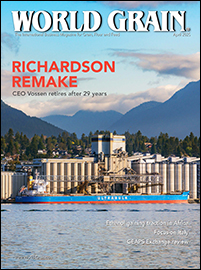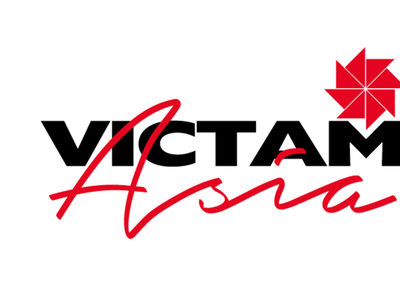Photo courtesy of MFA, Inc.
Under construction for the past year, the rail facility is a joint venture between MFA Inc., a grain marketing and farm supply cooperative, and MFA Oil Co., a farmer-owned energy supply cooperative.
“As a cooperative, our core purpose is to contribute to the success of both our member owners and their communities,” said Ernie Verslues, chief executive officer (CEO) of MFA.”That has been a constant for over 100 years. Our long history is proof that we have constantly reinvented ourselves over time and continued to invest in the future. This facility is the latest example of that commitment.”
Located on Highway 36 in Caldwell County, the shuttle-loader facility will utilize an improved four-lane highway, proximity to north-south traffic on Interstate 35 and direct access to the Union Pacific Railroad. With a rail siding to accommodate a 110-car shuttle train, the facility is also known as a loop-loader because the track is in a circle connected to the main line. Railroads prefer to load grain via the shuttle method for ease of movement from a point of origin to a destination, MFA said.
The facility can move 60,000 bushels per hour, and the 110-car shuttle train will hold approximately 420,000 bushels of corn or 380,000 bushels of soybeans and can be loaded in fewer than eight hours. The operation will position MFA to potentially reduce truck traffic by as much as 14 million bushels of grain annually.
According to MFA, the facility will provide new efficiencies for its grain division as well as access to large and diverse markets such as exporters, poultry and cattle operations, and other end users of grain in areas that stretch from the Gulf Coast to the West Coast and Mexico.
The co-op also believes the new facility will benefit farmers in north central Missouri and southern Iowa by providing them a modern, high speed grain facility to deliver crops and quickly unload during peak seasons.
“The grain business, as well as the grain farmer, continue to evolve in Missouri,” said Mitch Dawson, director of grain operations at MFA. “At MFA, we have to evolve as well. Our new Hamilton shuttle-loader positions us to hit new markets that were not economically feasible before due to freight costs and volume shipment requirements. It shows that MFA is in the grain business for the long haul.”
While the Hamilton facility is designed to move grain rather than store it, there are 2 million bushels of permanent grain storage and 1.5 million bushels of temporary storage on site. This can help relieve harvest-time pressure on existing MFA grain-receiving facilities in the region, MFA said.
According the2017 Grain & Milling Annual, MFA, Inc. has a total of 77 grain storage facilities with a total licensed grain storage capacity of 44.2 million bushels. It has four river facilities and 73 country elevators.
“There is a lot of grain produced in north central and northwest Missouri, and harvest is a critical time for farmers,” said Adam McIntyre, regional manager for MFA locations in the area. “During high-volume periods, we can move grain from smaller elevators to the shuttle loader to keep local storage capacity available.”
The joint venture between MFA Inc. and MFA Oil Co. brings resources and expertise from both cooperatives and a significant investment in local communities. The facility will be operated by MFA Inc. with seven full-time employees, including David Jones, manager, and offer seasonal part-time jobs as demand grows.
“This facility will deliver great value to the farmer-members of both cooperatives, and we are proud to partner with MFA Inc. in bringing it to fruition, " said Mark Fenner, president and CEO of MFA Oil. “Farmers count on fast, convenient and reliable transportation networks to move their grain, and we are confident the shuttle-loader’s connection to the Union Pacific Railroad will prove to be a prudent investment.”






